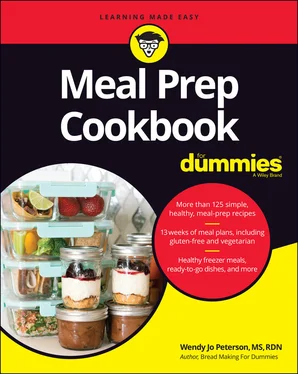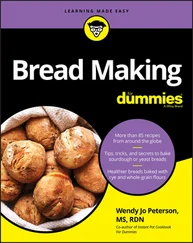If you’re okay with eating the same thing all week, if you prefer cooking only one day and reheating for a meal, or if you’re really tight on time for the week, this approach is for you.
 Be sure to get some variety. Eating the same thing for every dinner doesn’t provide a variety of nutrients, so consider mixing up the proteins and vegetables each week to ensure you’re getting enough nutrients.
Be sure to get some variety. Eating the same thing for every dinner doesn’t provide a variety of nutrients, so consider mixing up the proteins and vegetables each week to ensure you’re getting enough nutrients.
 One potential downside to this approach is boredom. By day 3, the drive-thru may be more tempting than microwaving the same meal again or eating the same salad.
One potential downside to this approach is boredom. By day 3, the drive-thru may be more tempting than microwaving the same meal again or eating the same salad.
Batch cooking is a budget-friendly way to cook large portions of meat or vegetables and then create different meals with them for the week. Chapters 9– 13highlight ways to make popular large cuts of meat and ways the meats can be used in different meals to keep it fun and new.
Batch cooking requires buying meat in bulk and spending a good amount of time to roast or pressure-cook the meat in advance. While the meat is cooking, you can utilize the time to prep meals you want to make with the meat for the week.
If you prefer to buy meat in bulk, if you have the time to slow-roast or cook the meat on one day, and if you don’t mind eating the same meat all week, this method is for you. (You could also freeze the cooked meat and use it another week, if you don’t want to eat the same meat all week.)
If you love your Instant Pot or slow cooker this may be the style of meal prep for you! You just need the freezer space to store the meals.
Plan freezer-friendly, slow-cooker, or multicooker meals. Prep and place the meals in freezer bags, label the bags, and freeze them for another day within the next month.
If you don’t have much time to meal-prep every week and you prefer to knock meals out for the month; if you have ample freezer space (like a deep freezer); or if you absolutely love stews, soups, and pot roasts, this method is for you. During cold months, this approach may be especially appealing; perhaps less so in the summer. Check out Chapters 7and 15if this method appeals to you. I like having these meals on hand; I work them in throughout the week to mix things up!
Sheet-pan meals have become incredibly popular and are super simple. The concept is that you have your protein, vegetables, and starch all on one sheet pan that roasts for the same time and yields a complete meal when it’s done cooking. The trick is having each element cook at the same temperature and time, but the bonus is less cleanup!
Plan a starch, protein, and vegetable that can cook at the same time and temperature (or head to Chapter 14where I’ve done the work for you!). Prep each element in advance and store them together. (For example, marinate your vegetables, create a spice mix for your protein, and cut up potatoes and store them in water prior to cooking.) Then, when it’s time to execute, place each element on a parchment-lined sheet pan, roast, and serve.
If you have the oven space, you’re cooking for fewer than four people, if you have the time and refrigerator space to prep and store, and if you don’t mind heating up your home with the oven, this method is for you.
 If you have a larger family, you can use more sheet pans and oven racks.
If you have a larger family, you can use more sheet pans and oven racks.
No, this method isn’t about breaking out a scale and doing math equations! Instead, the formula is more about planning a protein, a starch, and a vegetable, and keeping it simple. Honestly, this is about 50 percent of how I do meal prep. Every week, I harvest vegetables or pick up something from my local farmer’s market that inspires a meal. I keep meat stocked in my freezer that I pull out for the week. Then I find a yummy starch (rice, couscous, pasta, or potatoes) to pair with the meal. This is where sauces come in handy. Head to Chapter 20where I highlight sauces just for these occasions.
Get inspired by your local, in-season produce or protein deals at your favorite market. Create a meal plan that accounts for a protein, vegetables, and add a starch. From here, you can do partial prep for the week and pull together a quick meal. Having a well-stocked pantry is essential with this type of meal prep!
If you like to create meals from bargain buys or seasonal produce, if you get a community supported agriculture (CSA) box or you have a vegetable garden, if you buy meat in bulk and need to work through it in your freezer, or if the idea of this simple formula (protein + veggies + starch) appeals to you, this method is for you. Head to Chapters 16, 17, and 20for recipes to start with.
Hammering Out “Build-Your-Own” Bars
Salad bars, potato bars, pizza bars, taco bars, sandwich bars … maybe meal prep in your house needs to speak to many different taste buds. If this is the case, creating a “bar” is a great approach.
Let your family members build their own meals. Plan out your favorite toppings, prep them in separate containers for the meal, store them, and pull them out to serve. This can be the ultimate family-style dining experience. Taco bars, salad bars, and potato bars are my family’s favorites for the week. Roasting potatoes in advance or using the microwave can make this bar come together quickly.
Creating bars can help win the war with picky eaters. As a dietitian and a parent, I encourage you to let go of the dinnertime battles and empower your kids to serve themselves what they want to eat. We follow Ellyn Satter’s ( www.ellynsatterinstitute.org ) Division of Responsibility, which means parents get to decide what will be served, when, and where, and the kid gets to decide if they eat and how much. I recommend always serving something they like on the “bar” but letting go of any other battles around the food after that. There’s a lot of sound research out there supporting the Division of Responsibility. If you have a picky eater, head to Ellyn’s website for added support! Now, “bars” don’t require recipes, but if this sounds like you, head to Chapters 16and 17for baked potato and seasonal salads inspiration!
When meal planning, consider everyone who eats with you. If you have a picky eater in the house, consider offering at least one to two food items that you know they’ll eat, but continue to serve other options, as well. For example, if your picky eater likes apples, peanut butter, and yogurt, make sure you have two of those offered at the table for each meal. When you take the time to plan and prep for the week, make sure that meals fit the tastes of your family. You can also remove a lot of unwanted arguments and pressure around the table and mealtimes.
Читать дальше

 Be sure to get some variety. Eating the same thing for every dinner doesn’t provide a variety of nutrients, so consider mixing up the proteins and vegetables each week to ensure you’re getting enough nutrients.
Be sure to get some variety. Eating the same thing for every dinner doesn’t provide a variety of nutrients, so consider mixing up the proteins and vegetables each week to ensure you’re getting enough nutrients. One potential downside to this approach is boredom. By day 3, the drive-thru may be more tempting than microwaving the same meal again or eating the same salad.
One potential downside to this approach is boredom. By day 3, the drive-thru may be more tempting than microwaving the same meal again or eating the same salad.










